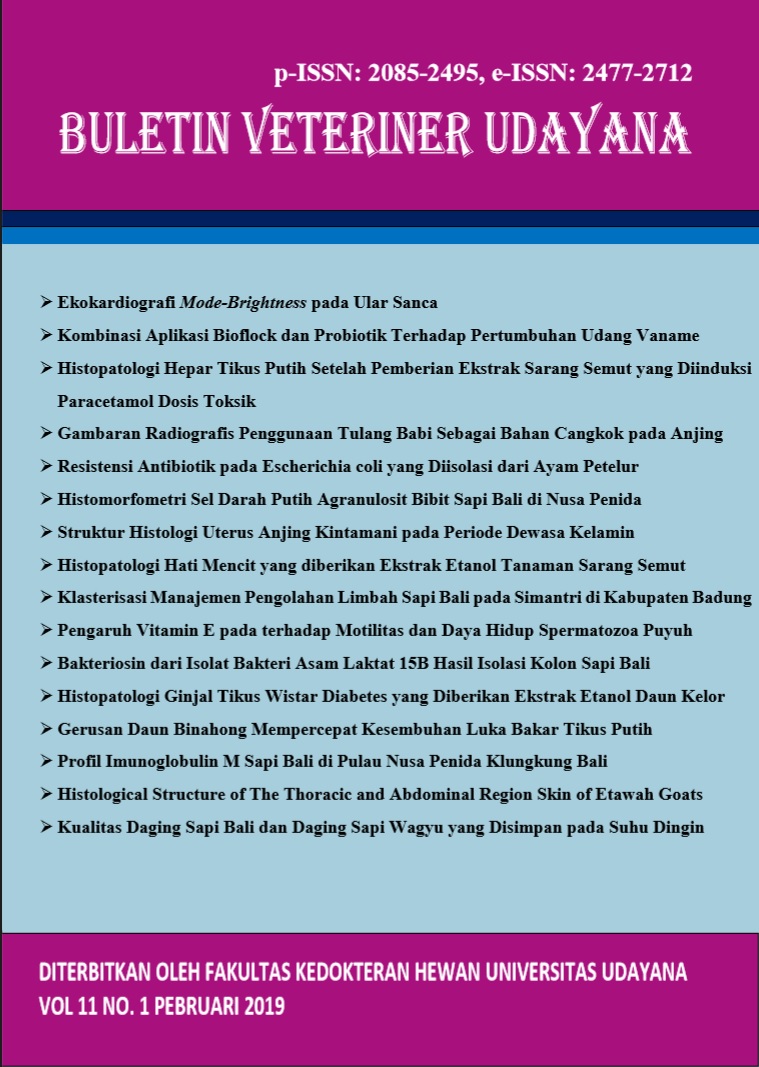BRIGHTNESS-MODE EKOCARDIOGRAPHY ON THE PHYTON SNAKES
Abstract
Echocardiography is one of the health diagnostic techniques of cardiac organ by utilizing high-frequency sound waves that are non-invasive, safe, fast, and easy to do. This echocardiography study aims to observe the structure, position, and size of cardiac organ in the three species of phyton (Sanca), namely Sanca batik, Sanca bodo, and Sanca bola. The cardiac organs were imaged using ultrasonography of brightness mode with a 10 MHz linear type transducer and using a water medium as an ultrasound gel. Snakes were handled and restrained physically, without the use of sedation or anesthesia. The position of the cardiac organ is measured by the number of the ventral scales, while the size of the cardiac organ is measured by the sum of the number of ventral scales. The results indicate that the position of the cardiac organ is at the number 55-77 ventral scales, while the size of the cardiac organ ranges from 12-13 ventral scales. The position of the cardiac organ on Sanca batik tends to be more anterior than Sanca bodo and Sanca bola. Ultrasonographic in longitudinal standard view shows the cardiac parts of the sinus venosus, right atrium, left atrium, cavum arteriosum, cavum venosum, cavum pulmonale, pulmonary artery, and aorta. Whereas in transversal standard view shows parts of cavum venosum, cavum pulmonale, cavum arteriosum, and aorta. The muscle of the cardiac organs has a gray (hypoechoic) echogenicity with a blood vessel that appears to be black (anechoic). While the more clayey’s cardiac tissue appeared as white color (hyperechoic).
Downloads
References
Badeer HS. 1998. Anatomical position of heart in snakes with vertical orientation: a new hypothesis. Comp. Biochem. Physiol. Part A: Mol. Integ. Physiol. 119(1): 403-405.
Coucelo J, Coucelo J, Azevedo J. 1996. Ultrasonography characterization of heart morphology and blood flow of lower vertebrates. J. Exp. Zool. 275: 73-82.
Farrell AP, Gamperl AK, Francis ETB. 1998. Comparative aspects of heart morphology. In Gans C, Gaunt AS: Biology of the Reptilia vol. 19, Morphology G. Visceral organs. Society for the Study of Amphibians and Reptiles. New York (USA): Ithaca. Pp. 375-424.
Frye FL. 1991. Biomedical and Surgical Aspects of Captive Reptile Husbandry 2nd ed. Melbourne: FL Krieger Publishing. Pp. 481.
Frye FL. 1994. Diagnosis and surgical treatment of reptilian neoplasms with a compilation of cases 1966-1993. In Vivo. 8(5): 885-892.
Funk RS. 1996. Biology - snakes. In Mader DR (ed): Reptile Medicine and Surgery. Philadelphia: WB Saunders Co. Pp. 39-46.
Gammal E, Auer T, Hoffmann K, Matthes U, Altmeyer P, Ermert H. 1993. High-frequency ultrasound: a non-invasive method for use in dermatology. In Noninvasive Methods in Dermatology, Frosch P, Kligman A. Heidelberg: Springer Verlag. Pp. 104.
Gartner GEA, Hicks JW, Manzani PR, Andrade DV, Abe AS, Wang T, Secor SM, Garland T. 2010. Phylogeny, ecology, and heart position in snakes. Physiol. Biochem. Zool. 83: 43-54.
Gnudi G, Volta A, Ianni F, Bonazzi M, Manfredi S, Bertoni G. 2009. Use of ultrasonography and contrast radiography for snake gender determination. Vet. Radiol. Ultrasound. 50(3): 309-311.
Hall J. 2011. Guyton and Hall textbook of medical physiology 12th Ed. Philadelphia (US): Saunders/Elsevier.
Hruban Z, Vardiman E, Meehan T. 1992. Hematopoietic neoplasms in zoo animals. J. Comp. Pathol. 106: 15-24.
Isaza R, Ackerman N, Jacobson ER. 1993. Ultrasound imaging of the coelomic structures in the Boa constrictor (Boa constrictor). Ve. Radiol. Ultrasound. 34(6): 445-450.
Jacobson ER, Homer B, Adams W. 1991. Endocarditis and congestive heart failure in a burmese python (Python molurus bivittatus). J. Zoo Wildlife Med. 22: 245-248.
Konell A, Sanson BC, Giannico AT, Werner J, Ferreira FM, Froes TR, Lange RR. 2015. Cardiac thrombus in a burmese python (Python molurus bivittatus). The Herpetological Bul. 131: 13-16.
Lestari NAA,Pertiwi AP, Kombo MP, Tumbelaka L, Ulum MF. 2017. Pencitraan ultrasonografi organ hepatobiliari pada ular sanca. ARSHI Vet. Letters. 1(2): 29-30.
Lindell L, Forsman A, Merila J. 1993. Variation in number of ventral scales in snakes: effects of body size, growth rate and survival in the adder (Vipera berus). J. Zool. 230: 101-115.
Murray MJ. 1996. Cardiology and circulation. In Mader DR (ed): Reptile Medicine and Surgery. Philadelphia: WB Saunders Co. Pp. 95-104.
Noviana D, Aliambar S, Ulum M, Siswandi R. 2012. Diagnosis Ultrasonografi pada Hewan Kecil. Bogor (ID): IPB Press. Pp. 8.
Schildger BJ, Casares M, Kramer M, Spörle H, Gerwing M, Rübel A, Tenhu H, Göbel T. 1994. Technique of ultrasonography in lizards, snakes and chelonians. Seminars in Avian and Exotic Pet. Med. 3: 147-155.
Schilliger L, Chetboul V, Tessier D. 2005. Standardizing two-dimentional echocardiographic examination in snakes. Exotic DVM. 7(3): 63.
Snyder PS, Shaw NG, Heard DJ. 1999. Two-dimensional echocardiographic anatomy of the snake heart (Python molurus bivittatus). Vet. Radiol. Ultrasound. 40: 66-72.
Stahlschmidt Z, Brashears J, DeNardo D. 2011. The use of ultrasonography to assess reproductive investment and output in pythons. Biol. J. Linnean Soc. 103: 772-778.
van Soldt BJ, Metscher BD, Poelmann RE, Vervust B, Vonk FJ, Muller GB, Richardson MK. 2015. Heterochrony and early left-right asymmetry in the development of the cardiorespiratory system of snakes. PLoS ONE. 10(1): e116416.
Vosjoli P. 2003. The Ball Python Manual. California (USA): Advanced Vivarium Systems. Pp. 7.





